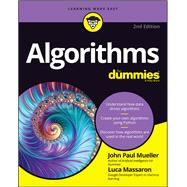Your secret weapon to understanding—and using!—one of the most powerful influences in the world today
From your Facebook News Feed to your most recent insurance premiums—even making toast!—algorithms play a role in virtually everything that happens in modern society and in your personal life. And while they can seem complicated from a distance, the reality is that, with a little help, anyone can understand—and even use—these powerful problem-solving tools!
In Algorithms For Dummies, you'll discover the basics of algorithms, including what they are, how they work, where you can find them (spoiler alert: everywhere!), who invented the most important ones in use today (a Greek philosopher is involved), and how to create them yourself.
You'll also find:
- Dozens of graphs and charts that help you understand the inner workings of algorithms
- Links to an online repository called GitHub for constant access to updated code
- Step-by-step instructions on how to use Google Colaboratory, a zero-setup coding environment that runs right from your browser
Whether you're a curious internet user wondering how Google seems to always know the right answer to your question or a beginning computer science student looking for a head start on your next class, Algorithms For Dummies is the can't-miss resource you've been waiting for.









